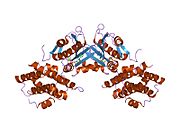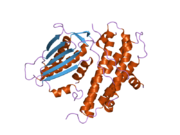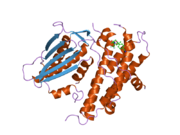PDK2
Ensembl | |||||||||
|---|---|---|---|---|---|---|---|---|---|
| UniProt | |||||||||
| RefSeq (mRNA) | |||||||||
| RefSeq (protein) | |||||||||
| Location (UCSC) | Chr 17: 50.09 – 50.11 Mb | Chr 11: 94.92 – 94.93 Mb | |||||||
| PubMed search | [3] | [4] | |||||||
| View/Edit Human | View/Edit Mouse |
Pyruvate dehydrogenase kinase isoform 2 (PDK2) also known as pyruvate dehydrogenase lipoamide kinase isozyme 2, mitochondrial is an enzyme that in humans is encoded by the PDK2 gene.[5][6] PDK2 is an isozyme of pyruvate dehydrogenase kinase.
Structure
The protein encoded by the PDK2 gene has two sites, an
Function
The Pyruvate Dehydrogenase (PDH) complex must be tightly regulated due to its central role in general metabolism. Within the complex, there are three serine residues on the E1 component that are sites for phosphorylation; this phosphorylation inactivates the complex. In humans, there have been four
Regulation
As the primary regulators of a crucial step in the central metabolic pathway, the pyruvate dehydrogenase family is tightly regulated itself by a myriad of factors. PDK2 activity is modulated by low levels of hydrogen peroxide; this happens because the compound temporarily oxidizes the cysteine residues 45 and 392 on the enzyme, resulting in an inactive PDK2 and greater PDH activity. These conditions also inactivate the
Clinical significance
All of the pyruvate dehydrogenase isozymes have been associated with various metabolic disorders, including
Cancer
As the PDK enzymes are associated with central metabolism and growth, they are often associated with various mechanisms of cancer progression. Enhanced PDK2 activity leads to increased
References
- ^ a b c GRCh38: Ensembl release 89: ENSG00000005882 – Ensembl, May 2017
- ^ a b c GRCm38: Ensembl release 89: ENSMUSG00000038967 – Ensembl, May 2017
- ^ "Human PubMed Reference:". National Center for Biotechnology Information, U.S. National Library of Medicine.
- ^ "Mouse PubMed Reference:". National Center for Biotechnology Information, U.S. National Library of Medicine.
- PMID 7499431.
- ^ "Entrez Gene: PDK2 pyruvate dehydrogenase kinase, isozyme 2".
- PMID 16401071.
- PMID 18627174.
- PMID 19833728.
- PMID 11485553.
- PMID 21411764.
- PMID 22910903.
- PMID 17669420.
- PMID 16483874.
- PMID 22123926.
- PMID 22614004.
Further reading
- Sugden MC, Holness MJ (May 2003). "Recent advances in mechanisms regulating glucose oxidation at the level of the pyruvate dehydrogenase complex by PDKs". American Journal of Physiology. Endocrinology and Metabolism. 284 (5): E855–62. PMID 12676647.
- Kobayashi T, Cohen P (Apr 1999). "Activation of serum- and glucocorticoid-regulated protein kinase by agonists that activate phosphatidylinositide 3-kinase is mediated by 3-phosphoinositide-dependent protein kinase-1 (PDK1) and PDK2". The Biochemical Journal. 339 (2): 319–28. PMID 10191262.
- Gold MR, Scheid MP, Santos L, Dang-Lawson M, Roth RA, Matsuuchi L, Duronio V, Krebs DL (Aug 1999). "The B cell antigen receptor activates the Akt (protein kinase B)/glycogen synthase kinase-3 signaling pathway via phosphatidylinositol 3-kinase". Journal of Immunology. 163 (4): 1894–905. PMID 10438924.
- Baker JC, Yan X, Peng T, Kasten S, Roche TE (May 2000). "Marked differences between two isoforms of human pyruvate dehydrogenase kinase". The Journal of Biological Chemistry. 275 (21): 15773–81. PMID 10748134.
- Steussy CN, Popov KM, Bowker-Kinley MM, Sloan RB, Harris RA, Hamilton JA (Oct 2001). "Structure of pyruvate dehydrogenase kinase. Novel folding pattern for a serine protein kinase". The Journal of Biological Chemistry. 276 (40): 37443–50. PMID 11483605.
- Kolobova E, Tuganova A, Boulatnikov I, Popov KM (Aug 2001). "Regulation of pyruvate dehydrogenase activity through phosphorylation at multiple sites". The Biochemical Journal. 358 (Pt 1): 69–77. PMID 11485553.
- Korotchkina LG, Patel MS (Oct 2001). "Site specificity of four pyruvate dehydrogenase kinase isoenzymes toward the three phosphorylation sites of human pyruvate dehydrogenase". The Journal of Biological Chemistry. 276 (40): 37223–9. PMID 11486000.
- Peters SJ, Harris RA, Wu P, Pehleman TL, Heigenhauser GJ, Spriet LL (Dec 2001). "Human skeletal muscle PDH kinase activity and isoform expression during a 3-day high-fat/low-carbohydrate diet". American Journal of Physiology. Endocrinology and Metabolism. 281 (6): E1151–8. S2CID 22798857.
- Tuganova A, Boulatnikov I, Popov KM (Aug 2002). "Interaction between the individual isoenzymes of pyruvate dehydrogenase kinase and the inner lipoyl-bearing domain of transacetylase component of pyruvate dehydrogenase complex". The Biochemical Journal. 366 (Pt 1): 129–36. PMID 11978179.
- Boulatnikov I, Popov KM (Feb 2003). "Formation of functional heterodimers by isozymes 1 and 2 of pyruvate dehydrogenase kinase". Biochimica et Biophysica Acta (BBA) - Proteins and Proteomics. 1645 (2): 183–92. PMID 12573248.
- Hiromasa Y, Roche TE (Sep 2003). "Facilitated interaction between the pyruvate dehydrogenase kinase isoform 2 and the dihydrolipoyl acetyltransferase". The Journal of Biological Chemistry. 278 (36): 33681–93. PMID 12816949.
- Watt MJ, Heigenhauser GJ, LeBlanc PJ, Inglis JG, Spriet LL, Peters SJ (Oct 2004). "Rapid upregulation of pyruvate dehydrogenase kinase activity in human skeletal muscle during prolonged exercise". Journal of Applied Physiology. 97 (4): 1261–7. PMID 15169745.
- Bao H, Kasten SA, Yan X, Roche TE (Oct 2004). "Pyruvate dehydrogenase kinase isoform 2 activity limited and further inhibited by slowing down the rate of dissociation of ADP". Biochemistry. 43 (42): 13432–41. PMID 15491150.
- Bao H, Kasten SA, Yan X, Hiromasa Y, Roche TE (Oct 2004). "Pyruvate dehydrogenase kinase isoform 2 activity stimulated by speeding up the rate of dissociation of ADP". Biochemistry. 43 (42): 13442–51. PMID 15491151.
- Abbot EL, McCormack JG, Reynet C, Hassall DG, Buchan KW, Yeaman SJ (Jun 2005). "Diverging regulation of pyruvate dehydrogenase kinase isoform gene expression in cultured human muscle cells". The FEBS Journal. 272 (12): 3004–14. S2CID 21366281.







